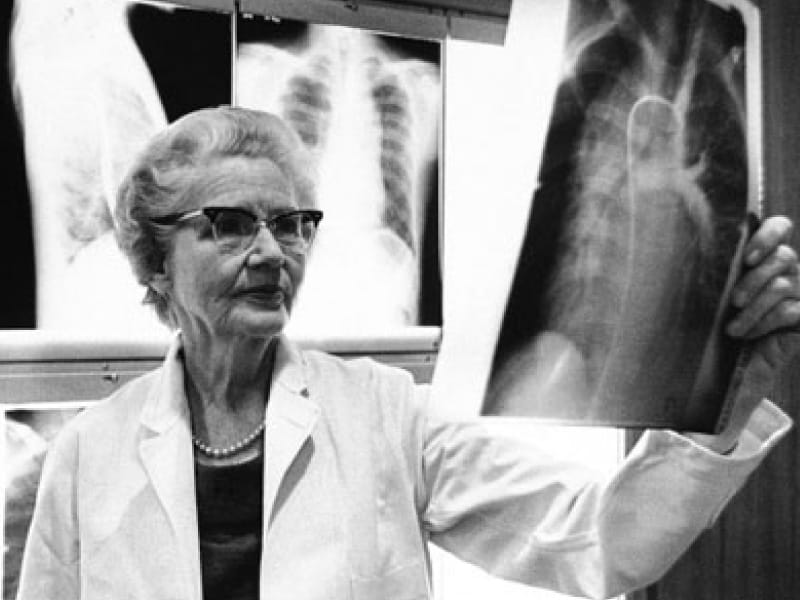Helen Taussig’s incredible story is a testament to the resilience of the human spirit. Despite being born with significant challenges, she not only overcame them but went on to change the course of medicine, saving thousands of lives along the way. Her journey from a girl who couldn’t read or hear to the pioneer of pediatric cardiology is an inspiring narrative of determination, grit, and compassion.
The Struggles of Childhood
Helen Taussig’s childhood was marked by struggle. As a young girl, reading was an overwhelming challenge. Her severe dyslexia meant that the letters on the page swam around, making it nearly impossible to form words. While her peers breezed through books, Helen fought for each sentence, navigating the complex world of letters that never seemed to make sense. The frustration of being unable to read at a time when literacy was key to success set the stage for a deep sense of inadequacy. Yet, even in the face of this daunting challenge, Helen found a way to push forward.
As if dyslexia wasn’t enough of an obstacle, Helen was also faced with a deteriorating hearing condition. By her twenties, she began losing her hearing. The world grew quieter and more distant, a place where sounds faded into a faint, muffled hum. These compounded difficulties would have caused many to give up, but not Helen. She adapted and pushed forward, developing methods to cope with her circumstances and continually proving that no obstacle was insurmountable.
A Battle for Medical School Admission
Helen’s path to becoming a doctor was not an easy one. In the 1920s, medical schools were far from welcoming to women, and even though Helen’s determination was unwavering, the road was filled with obstacles. Harvard University, one of the premier institutions of the time, allowed Helen to audit classes but made it clear she would never receive a degree. Boston University offered a more favorable path but imposed conditions that would have discouraged many: sit in the back of the class, do not speak to male students, and essentially remain invisible.
However, Helen Taussig was not one to be silenced. Determined to succeed, she found ways to teach herself, overcoming the limitations placed on her. She became proficient in lip-reading, memorized material she couldn’t fully hear, and studied relentlessly. Where others might have seen only a wall, Helen saw a way forward. She refused to accept limitations and relentlessly worked towards her goal of becoming a doctor.
The Birth of a Medical Innovator
In the 1940s, after years of perseverance, Helen was working at the prestigious Johns Hopkins Hospital in Baltimore, where she focused on pediatric cardiology, specializing in children born with heart defects. It was here that she would come across something that would change her life’s work—and the lives of thousands of children.
At Johns Hopkins, Helen encountered a heartbreaking sight—infants born with severe heart defects who were turning blue due to the lack of oxygen being pumped through their bodies. These babies were slowly dying, and parents were left with nothing but heartbreak. There was no treatment. No solution. Just the cold reality that these children would not survive.
Helen refused to accept this reality. Instead of giving in to despair, she formulated a daring theory: what if blood flow could be rerouted around the defective heart structures? This idea was revolutionary. At the time, heart surgery was in its infancy, and the concept of operating on such fragile beings, let alone performing surgery on their tiny hearts, seemed impossible. But Helen was determined to find a way.

The Blalock-Taussig Shunt: A Breakthrough in Pediatric Medicine
Helen Taussig brought her theory to Dr. Alfred Blalock, a respected surgeon, and surgical technician Vivien Thomas. Together, this trio of brilliant minds embarked on years of experimentation and refinement, perfecting what would become a groundbreaking surgery. In 1944, they performed the first successful Blalock-Taussig shunt, a surgical procedure that rerouted blood flow to bypass the defective heart structures.
The surgery was performed on a baby named Eileen Saxon, a young girl whose skin was a sickly blue, a telltale sign of her oxygen-starved body. When the procedure was complete, Eileen’s skin began to change from blue to pink. It was a miraculous sight: the baby girl was saved, and for the first time, there was hope for children with similar heart conditions.
The news of this success spread like wildfire. Parents from across the country, desperate for a chance to save their children, began traveling to Johns Hopkins. It wasn’t long before the hospital halls were filled with children who had been given death sentences, but who, thanks to Dr. Taussig’s pioneering work, were now given the chance to live.
Helen’s work did not stop there. The Blalock-Taussig shunt became a critical procedure in the fight against congenital heart defects, and thousands of children who would have died now went on to live full lives, free of the debilitating effects of heart defects.
Changing the Face of Medicine
Dr. Helen Taussig’s impact went far beyond her work with the Blalock-Taussig shunt. She went on to become the first woman to achieve the rank of full professor at Johns Hopkins, breaking barriers in an institution that had long been dominated by men. She became the founder of pediatric cardiology, a field that had not existed before her. And she did all of this while overcoming tremendous personal obstacles.
In the 1960s, when the drug thalidomide was being considered for approval in the United States, it was Helen who took it upon herself to investigate the drug. She discovered the dangers it posed, particularly to pregnant women, and worked tirelessly to prevent its approval. Her vigilance saved countless lives and prevented a potential tragedy in the U.S.
In recognition of her extraordinary contributions to medicine and society, Helen received numerous accolades, including the Presidential Medal of Freedom. She was inducted into the National Women’s Hall of Fame, and her legacy continues to inspire generations of doctors, scientists, and women around the world.

Legacy of Compassion and Innovation
Helen Taussig’s story is not only one of overcoming adversity but also one of profound compassion. Her work saved thousands of lives, and her dedication to helping those in need was unparalleled. In a world that often seeks to define us by our limitations, Helen proved that those very limitations could be the fuel for our greatest accomplishments.
She never let the challenges of her early life define her. Instead, she used them as motivation to push harder, see clearer, and care deeper. Her refusal to remain silent in the face of injustice and her unwavering commitment to her patients—especially the children who had no voice—set her apart as a true medical pioneer.
Today, Helen Taussig’s legacy lives on in the field of pediatric cardiology and in the lives of the countless children who benefited from her work. She showed the world that no matter the obstacles, a compassionate heart and a determined mind could change the course of history.
Her story continues to serve as a powerful reminder that the greatest challenges can lead to the most remarkable achievements, and that one individual, armed with determination and a vision, can indeed change the world.


